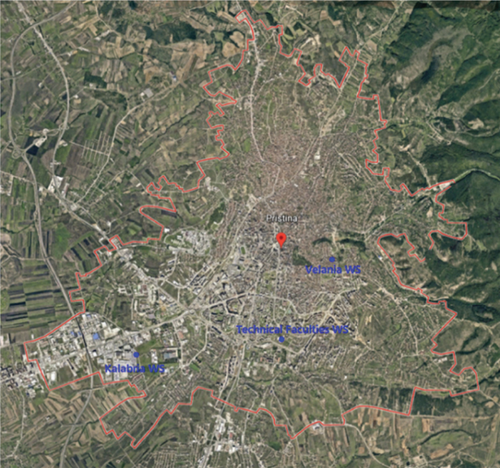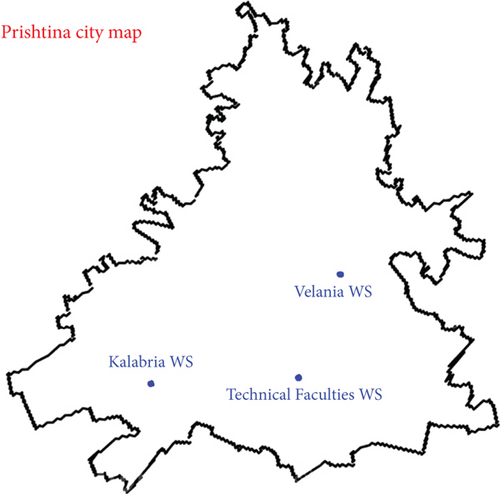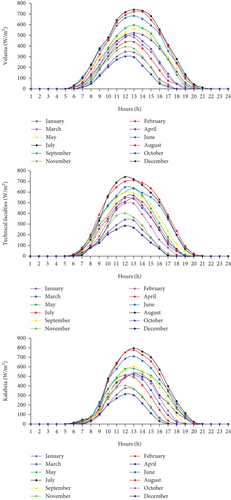Estimation of Power Production Potential From Solar Radiation and Wind Data in the Urban Area of Prishtina
Abstract
For the estimation of power production from any energy resource, premeasuring is very important, where one will approximate the power production potential from the resource planned to be installed. Weather data are crucial if the chosen resources depend on the weather, such as wind and solar energy. In this paper, three weather stations are identified in three different areas inside the urban area of Prishtina City (Velania neighborhood, Technical Faculties, and Kalabria neighborhood), Kosovo. The paper aims to analyze the potential of solar and wind resources in these three locations and also identifying which of these two resources is more efficient when installed in any of the three areas mentioned above. For this study purpose, there are analyzed wind and solar data from the three locations for the years 2018–2020. The primary data taken for this research are wind velocity, wind direction, and solar radiation. The study includes the amount of electricity that can be supplied by installing solar and wind energy resources inside the urban area of Prishtina. Results of the study show that solar resources are much more suitable for installation in the urban area of Prishtina and produce much more power than wind resources, which might be used as a secondary source, to cover the power production needs during the night and part of the year when the amount of solar radiation is lower. Results also show that the use of these two renewable resources is very profitable on reducing pollution, specifically the CO2 emission.
1. Introduction
Due to ongoing industrialization, an increase in living standards, and many other factors, power consumption has been rising continuously since the last century [1]. Except for the pandemic year 2020, electricity consumption in the world has increased yearly, reaching almost 24,000 tWh in 2019 [2]. Different resources produce this power, with coal still being the largest source of electricity globally [3]. Depending on the distance, around 5% of this electricity is lost in transmission [4]. That is why the electricity sources are more suitable to be installed as near the consumers as possible. Considering this fact, many researchers have explored the possibility of installing power resources near or even inside urban settings [5].
With a population of almost 2 million, Kosovo consumes around 4000 GWh of electricity per year [6]. Most of this amount of energy is produced by the Kosovo Energy Corporation (KEC) power plants, which use lignite as a fuel. Because the power production is concentrated mainly in one location, electricity losses in transmission in Kosovo are much higher, reaching around 25% or 1000 GWh per year [6]. One of the reasons for this high amount of energy losses is that the transmission network has not been changed in many locations, and the old network increases the amount of lost electricity.
Transmission losses can be reduced by installing power resources near or inside the urban areas, especially resources that do not harm the environment, such as wind and solar ones. The power from wind and solar resources is produced from wind turbines and photovoltaic (PV) panels, respectively. To assess the potential of power produced by these two sources, weather conditions over the area must be known.
Many studies have analyzed weather data regarding the power production potential for different countries and different time periods. Some studies are focused only on weather parameters (wind data, solar radiation data, or both). From these weather data, others calculate and estimate the power production potential that could be generated. Estimation of wind energy potential in Syria was done in 2003 [7], revealing the power that could be produced by installing wind turbines across Syria. A study on assessing both wind and solar resources was conducted in 2013 for the region of Serbia [8]. A similar study was done in 2011 for solar and wind resource complementarity, as options for renewable electricity integration in Ontario, Canada [9]. Another study from the weather perspective was conducted in 2017, where the local complementation of wind and solar energy resources over Europe has been analyzed [10]. The climatological relationship between solar and wind energy supply in Britain was part of a research paper which was conducted in 2016 in London [11]. Recently, in India, there was a research conducted where the development of a grid-connected solar–wind hybrid system was analyzed [12].
In 2020, a study was performed to present the overall power potential from different renewable energy sources in Kosovo [13]. The study was expanded to include renewable power potential from wind, solar, hydro, and biomass potential, presenting the environmental analysis for the emission that could be reduced by using these resources.
In the present study, there are identified three weather stations inside the urban area of Prishtina. The weather data are collected from these stations, with the main focus on the wind velocity, wind direction, and solar radiation. The data are presented to investigate the potential of power production from wind and solar resources in Prishtina City. The investigation may help Kosovo citizens that live in Prishtina to know about the amount of power that can be harnessed by any wind, solar, or their combination resources, so they may install appropriate systems for their own needs as individuals.
Investigation and research methodology are presented in the first chapter of the research. It includes a map showing the locations of the weather stations and presents diagrams of the wind and solar data. Chapter two presents the validation of data, where wind and solar data generated from the weather stations are compared with wind and solar data generated from Global Solar Atlas (GSA) and Global Wind Atlas (GWA). Chapter three includes the calculations of power that can be produced from wind and solar data presented in previous chapters. The presented results show that power production potential from solar radiation is much higher than the power production potential from wind resources. The random efficiency of 15% for solar panels is taken into calculations when showing the real power potential that can be generated from solar radiation. Discussion of the study aims and results are presented in chapter four. Chapter five includes the final conclusions of the research.
2. Investigation and Research Methodology
- 1.
Velania Weather Station (located in Velania neighborhood)
- 2.
Technical Faculties Weather Station (located on the rooftop of Technical Faculties Laboratory)
- 3.
Kosovo Hydrometeorological Institute (KHMI) Weather Station (located in Kalabria neighborhood)
The locations of the three weather stations are shown in Figure 1. Prishtina map, including the three locations where weather stations are located, is presented in satellite view and in blank map, where locations of the weather stations are more visible. The figure shows that the three locations cover a part of the area of Prishtina. Velania is a neighborhood of Prishtina located in the northeast part of the city, Kalabria neighborhood is located in the southwest part of the city, while Technical Faculties is located in the east part of the city center. The weather data from the three locations shown in Figure 1 are presented in this article. The data presented are average values extracted from the general data. General and detailed data are used for the drawing of solar radiation profiles when presenting the solar radiation data and wind roses, when presenting the wind velocity and direction data. Scientific assumptions and estimations are made based on the weather data presented to estimate the power that can be produced by wind and solar resources in all three areas of Prishtina.


2.1. Solar Radiation
Solar radiation is a source of energy derived from sunlight that is intercepted by the earth’s surface [16]. Solar radiation outside the atmosphere is called extraterrestrial radiation [16, 17]. It has an average value of 1367 W/m2, also known as the solar constant. On the other hand, global radiation is the radiation that hits the earth and depends on weather conditions [18]. Production of power from solar power resource is very much dependent on the global radiation and weather conditions. Solar global radiation can be divided into direct and diffuse radiation [19], although it is not crucial for the study case.
The annual sum of global radiation is another significant factor when planning to produce power from solar resources [20]. It represents the sum of solar radiation that is derived by the sunlight for 1 year per 1 m2. The annual sum of global radiation is measured in kilowatt-hour per square meter per year. It is separated into global horizontal radiation, measured on the flat earth, and global tilted irradiation, which is measured at an optimum angle [21]. According to the GSA, global horizontal radiation in Kosovo differs from 1300 kWh/m2/year in the north to almost 1500 kWh/m2/year in the west, while global tilted irradiation at the optimum angle varies from 1500 kWh/m2/year in the north up to 1700 kWh/m2/year in the west [22].
Solar radiation can be presented in different forms, but the sun hours and radiation per square meters are essential and one of the best ways to present solar radiation is in watts per square meter. Daily radiation data were taken every day from the weather stations, and they are collected during 2018, 2019, and 2020. Graphic diagrams presenting the hourly solar radiation profiles (watts per square meter) for all three locations are presented in Figure 2.

2.2. Wind Velocity and Direction
When considering wind turbines as renewable power generators, two weather data remain the most important: wind velocity and wind direction. There are two types of wind turbines: horizontal axis wind turbines (HAWTs) and vertical axis wind turbines (VAWTs) [23]. For VAWT, wind direction is not important, since its spin is not connected with wind direction but wind velocity only [24]. For HAWT, although wind velocity remains the most important data, wind direction is also important, since they have to face the wind direction for better efficiency. For this reason, HAWT is equipped with a yaw system, which keeps the turbine facing the wind direction when it changes [24].
For the chosen locations, wind velocity and wind direction data were also collected for 3 years between 2018 and 2020. Wind roses for the three locations are presented in Figure 3. While solar radiation is almost the same for all locations, wind velocity and direction change entirely from one location to another. Wind direction is mostly north, NNW, and NNE for Velania and Technical Faculties stations, while for Kalabria, NE and NNE are the most targeted directions. The average wind velocities for the 3 years come to 2.24 m/s at Velania, around 1.65 m/s at Technical Faculties, and 1.72 m/s at Kalabria. Differences in wind direction and velocity are understandable, since the urban setting interferes more with wind data than it does with solar radiation data. Buildings in urban areas lower the wind stream velocities and change their direction. There are many more differences in wind data for all three locations, which can be seen in Figure 3.

Average wind velocities under 2 m/s are not very profitable for wind power production. However, since wind roses show the results of only the overall average velocities for the whole 3 years, when analyzing power production potential from wind, monthly average data are calculated. This way, the potential of power production from wind will be calculated for every month.
3. Validation of the Data
In order to know if the data analyzed in this study case are correct, it is necessary to validate them using any other source that is validated in advance. For this research, data are validated using the well-known websites, from where solar radiation and wind velocity history data can be generated. Solar radiation, in this case the average solar radiation data gained from the all three weather station, is compared with average solar radiation data generated by GSA. Compression between the data for years 2018–2020 is presented in Figure 4. For the wind data validation, wind data are generated from GWA and are compared with the wind data gained from weather stations.

The comparison of average wind velocities between the two sources, also for years 2018–2020, is presented in Figure 5. Both wind and solar radiation data are generated for the same locations where weather stations are located.

Most of the time, the differences between the weather stations and GSA data are very low, never reaching a difference more than 15%. Differences in average wind velocities are a little higher, and this is quite expected, because of the obstacles that exist in urban areas where MS (meteorological stations) are located. Weather station in Kalabria, as mentioned earlier, is in fact the weather station of the Hydrometeorological Institute of Kosovo, which is the official weather institute of the country. Data from this resource do not necessarily need to be validated, but anyhow they are compared with data from both GSA and GWA. In the end, comparison results as shown in Figures 4 and 5 present very satisfying results and have the same trends like the GSA and GWA.
4. Wind and Solar Power Production Potential
In this section, it is presented the power production potential from wind and solar sources. The power production potential can be calculated using well-known equations for the wind velocity, wind direction, and solar radiation found for the three locations.
4.1. Solar Potential
The DNI and the real power that can be generated per month by a square meter of a PV panel are presented in Table 1.
| Months | Velania | Technical Faculties | Kalabria | |||
|---|---|---|---|---|---|---|
| DNI | Power generation | DNI | Power generation | DNI | Power generation | |
| (kWh/m2) | (kWh/m2) | (kWh/m2) | (kWh/m2) | (kWh/m2) | (kWh/m2) | |
| January | 62.83 | 9.42 | 60.04 | 9.01 | 59.37 | 8.90 |
| February | 79.13 | 11.87 | 83.08 | 12.46 | 76.74 | 11.51 |
| March | 107.46 | 16.12 | 107.50 | 16.13 | 104.44 | 15.67 |
| April | 121.93 | 18.29 | 114.80 | 17.22 | 107.50 | 16.12 |
| May | 142.66 | 21.40 | 137.24 | 20.59 | 133.48 | 20.02 |
| June | 169.28 | 25.39 | 157.53 | 23.63 | 155.72 | 23.36 |
| July | 190.64 | 28.60 | 182.45 | 27.37 | 179.00 | 26.85 |
| August | 177.68 | 26.65 | 176.15 | 26.42 | 167.06 | 25.06 |
| September | 130.01 | 19.50 | 129.14 | 19.37 | 117.17 | 17.57 |
| October | 101.08 | 15.16 | 105.72 | 15.86 | 100.78 | 15.12 |
| November | 68.84 | 10.33 | 67.10 | 10.06 | 65.25 | 9.79 |
| December | 52.18 | 7.83 | 50.17 | 7.53 | 49.38 | 7.41 |
| Total | 1403.71 | 210.56 | 1370.92 | 205.64 | 1315.88 | 197.38 |
The DNI for the three locations is all between 1315 and 1403 kWh/m2/year, while real power that can be generated is between 197 and 210 kWh/m2/year. Throughout the years, PV panels might have a degradation, so the efficiency of them lowers by age. According to many researches, the degradation of the PV panels is about 0.5% per year [25]. This is very important, because the power production will change when PV panels degrade and lower their efficiency.
4.2. Wind Potential
The average monthly power that could be produced by a turbine with the swept area of 1 m2 is presented in Table 2.
| Months | Velania | Technical Faculties | Kalabria | |||
|---|---|---|---|---|---|---|
| Avg. wind velocity | Real power potential | Avg. wind velocity | Real power potential | Avg. wind velocity | Real power potential | |
| (m/s) | (kWh/m2) | (m/s) | (kWh/m2) | (m/s) | (kWh/m2) | |
| January | 1.93 | 1.49 | 1.55 | 0.77 | 1.43 | 0.61 |
| February | 2.79 | 4.49 | 1.80 | 1.20 | 2.13 | 1.99 |
| March | 2.63 | 3.73 | 1.83 | 1.26 | 2.22 | 2.24 |
| April | 2.70 | 4.05 | 1.81 | 1.21 | 1.90 | 1.41 |
| May | 2.41 | 2.87 | 1.60 | 0.84 | 1.83 | 1.27 |
| June | 1.87 | 1.35 | 1.58 | 0.81 | 1.47 | 0.65 |
| July | 1.81 | 1.22 | 1.59 | 0.83 | 1.50 | 0.69 |
| August | 1.86 | 1.33 | 1.68 | 0.98 | 1.43 | 0.61 |
| September | 2.05 | 1.77 | 1.76 | 1.12 | 1.85 | 1.30 |
| October | 2.12 | 1.95 | 1.98 | 1.59 | 1.57 | 0.79 |
| November | 2.21 | 2.21 | 1.93 | 1.48 | 1.45 | 0.63 |
| December | 2.47 | 3.09 | 2.13 | 1.99 | 1.47 | 0.65 |
| Total | 29.55 | 14.08 | 12.84 | |||
Another very important analysis that can be very interesting to analyze and was an additional part of this paper was the analysis of the carbon savings or the reduction of carbon emission when using wind and solar resources. Reduction of the pollution by using renewable resources in Kosovo was studied earlier in 2022 [27]. The paper analyzes the amount of pollution that can be reduced by using renewable resources for power generation instead of coal-based power plant. Results show that an amount of around 2.5 kg of CO2 can be reduced for every kilowatt-hour of power produced. According to this result, an amount of 500–550 kg/year of CO2 can be reduced for every square meter of PV panel installed in Prishtina. At the same time, an amount of 30–70 kg/year of CO2 can be reduced for every wind turbine installed with a swept area of 1 m2.
5. Discussion of the Results
Solar radiation has given very satisfying results for the three locations analyzed in this study. The hourly DNI profiles have shown that solar radiation lasts from 10 h in winter up to 16 h in summer. Average DNI values per hour reach the maximum of 300 Wh/m2/day in winter and more than 700 Wh/m2/day in summer. This leads in the real electricity production of around 8 kWh/m2/month in cold months up to almost 30 kWh/m2/month in warmer months, for a random PV panel that has the efficiency of 15%. Annual power that could be produced is 198 kWh/m2/year in Kalabria, 205 kWh/m2/year in Technical Faculties, and 210 kWh/m2/year in Velania, although, with small changes in electricity production results, in Velania are shown the overall best results for the power produced, if PV panels are installed in this area.
Another fact that needs to be taken into account when installing PV panels is to take into consideration the degradation of the PV panels. The degradation of PV panels happens and the value of degradation is around 0.5% for every year of usage. This value needs to be taken into the calculation, when considering the installation of PV panels for electricity production for longer time periods.
The power production potential calculated for the given wind data has not shown very satisfying results. Average wind velocities per day, per month, and per year have shown quite low values. The wind velocity and direction also vary significantly in all three locations. This way, average annual wind velocity in Velania is 2.24 m/s, with wind blowing mostly in North, NNW, and NNE directions. At Technical Faculties, annual average wind velocity is 1.65 m/s and wind blows mostly from North and NNW directions. In Kalabria, the annual average is 1.72 m/s and wind blows mostly from NE and NNE directions. These differences in average wind velocity and in direction are caused by obstacles (mostly buildings) that are located near weather station areas. Obstacles change the direction of the wind and reduce its velocity.
After making the necessary calculations, this value of wind velocities has given the amount of electricity that could be produced in each of the three locations. The value on which the data are calculated is the electricity produced per square meter of the swept area of the turbine. As expected, results are not very high, with the electricity production of around 13 kWh/m2/year in Kalabria, 14 kWh/m2/year for Technical Faculties, and almost 30 kWh/m2/year for Velania. The 20% higher annual average wind velocity in Velania has resulted in 50% more power production potential. This is very much expected, since in the calculation for power production velocity is set to the third power.
In general, in Velania are shown better results on harnessing both solar and wind energy. The amount of power that could be generated is 210 kWh/m2/year from a square meter of PV panel installed and 30 kWh/m2/year for an installed wind turbine with a swept area of 1 m2. Table 3 shows the power potential that can be generated from solar radiation and wind data for all three weather stations.
| Velania | Annual solar power potential (kWh/m2/year) | 210.56 |
|---|---|---|
| Annual wind power potential (kWh/m2/year) | 29.55 | |
| Differences (kWh/m2/year) | 181.01 | |
| Technical Faculties | Annual solar power potential (kWh/m2/year) | 205.64 |
| Annual wind power potential (kWh/m2/year) | 14.08 | |
| Differences (kWh/m2/year) | 191.56 | |
| Kalabria | Annual solar power potential (kWh/m2/year) | 197.38 |
| Annual wind power potential (kWh/m2/year) | 12.84 | |
| Differences (kWh/m2/year) | 184.54 |
- Note: Entries in bold express the difference on power production between wind and solar resources, which is one of the most important parts of this study.
6. Conclusion
The solar radiation does not considerably change from one location to another within the city. While solar radiation does not considerably change, the wind velocity can vary significantly, mostly because of the obstacles around the location where the data are taken. The outcome of the study provides promising results on power production potential from solar source. Approximately 200 kWh of electricity can be produced from a square meter of the installed PV panel. On the other hand, the outcome of the study shows that the potential of wind resources is not very high and varies significantly from one location to another. While in Velania about 30 kWh of power can annually be produced from a turbine with a swept area of 1 m2, in Kalabria and Technical Faculties this amount of power is around 13–14 kWh/m2/year.
From this study, it can be concluded that installation of PV panels in Prishtina is very promising. At the same time, wind turbines may be installed as a secondary renewable energy source and can be combined with solar PV panels as a hybrid system. The conditions by which this hybrid system can generate the highest amount of power and give better results and efficiency remain to be studied in future research studies.
The amount of pollution that can be reduced by installation of these systems was an added part of the paper. Results show that an amount of around 2.5 kg of CO2 can be reduced for every kilowatt-hour of power produced. According to this result, an amount of 500–550 kg/year of CO2 can be reduced for every square meter of PV panel installed in Prishtina. At the same time, an amount of 30–70 kg/year of CO2 can be reduced for every wind turbine installed with a swept area of 1 m2.
Conflicts of Interest
The authors declare no conflicts of interest.
Funding
No funding was received for this paper.
Open Research
Data Availability Statement
Data are included in the paper.




